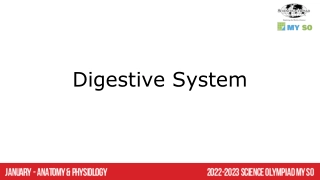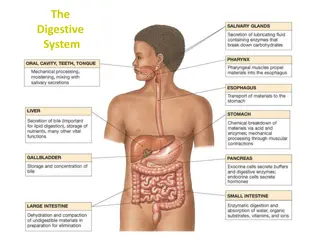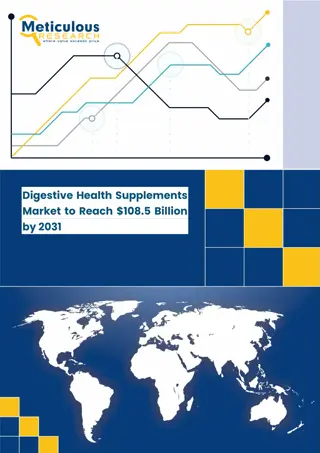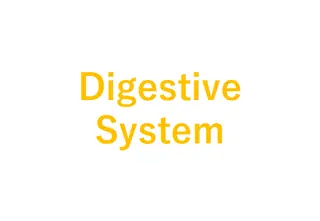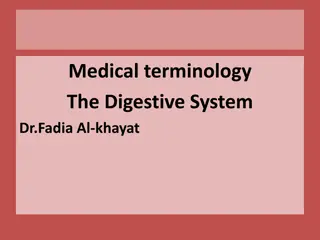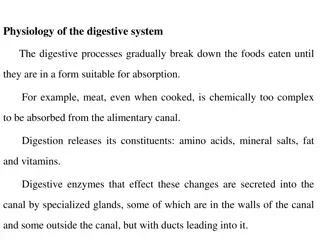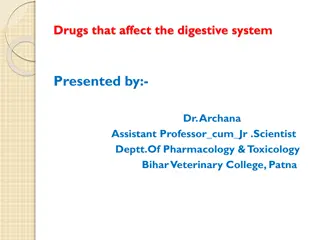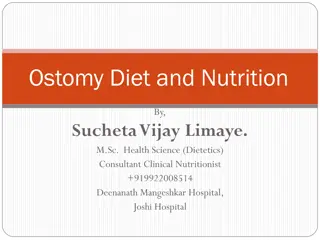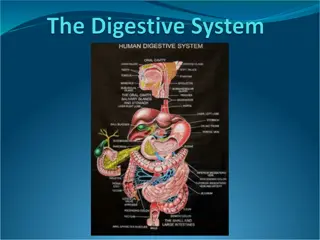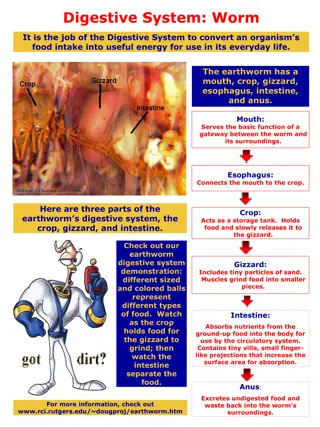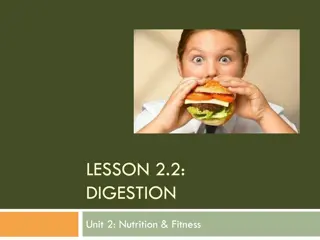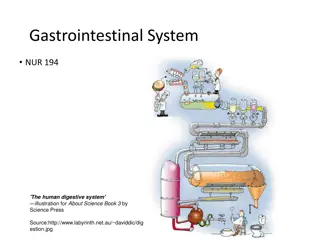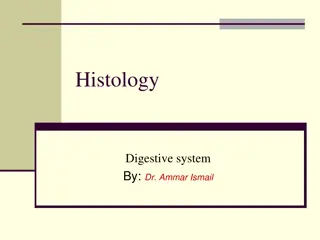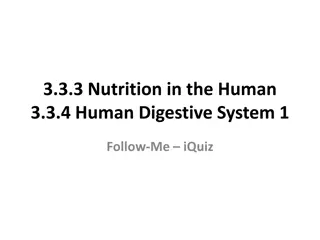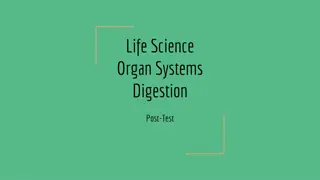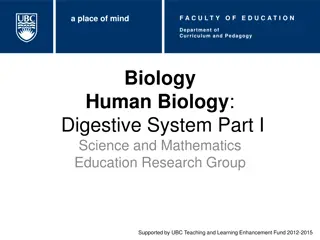Exploring the Intricacies of the Digestive System
The digestive system plays a crucial role in converting food into nutrients and eliminating waste from the body. It involves a complex network of organs such as the mouth, stomach, intestines, liver, pancreas, and gallbladder. Discover interesting facts and details about the digestive system, including its functions, the length of organs like the esophagus and intestines, and the roles of different structures. Explore images and fun facts to enhance your understanding of this essential bodily system.
Download Presentation

Please find below an Image/Link to download the presentation.
The content on the website is provided AS IS for your information and personal use only. It may not be sold, licensed, or shared on other websites without obtaining consent from the author. Download presentation by click this link. If you encounter any issues during the download, it is possible that the publisher has removed the file from their server.
E N D
Presentation Transcript
Digestive System https://kidshealth.org/en/kids/digestive-system.html
The digestive system has two main functions: 1. to convert food into nutrients your body needs, and to rid the body of waste. 2. To do its job, the system requires the cooperation of a number of different structures and organs throughout the body, including the mouth, stomach, intestines, liver, pancreas and gallbladder. 60
Hey there!! Here are 10 Fun Facts +1!! Hey there!! Here are 10 Fun Facts +1!! 1. An adult esophagus ranges from 10 to 14 inches in length, and 1 inch in diameter. 2. We make 1 to 3 pints of saliva a day. 3. Muscles contract in waves to move the food down the esophagus. Peristalsis action This means that food would get to a person's stomach, even if they were standing on their head 4. It takes your mouth, esophagus, stomach, small intestine, large intestine, gallbladder, pancreas and liver just to digest a glass of milk. 5. An adults stomach can hold approximately 1.5 liters of material. (1 to 1 quarts) 6. The average male will eat about 50 tons of food during his lifetime in order to sustain a weight of 150 pounds. 7. Within the colon, a typical person harbors more than 400 distinct species of bacteria. Gut Flora Lactobacillus-used in probiotic foods. E-coli bacteria PH 5.5-7 100 trillion bacteria in the gut! 300-1,000 species of bacteria in the digestive tract. 8. The liver is the largest organ in the body and performs more than 500 functions. Four functions I want you to know are: Breaks down toxins, produces bile, stores fat soluble vitamins A,D,K,E, and stores glycogen-sugar 9. The small intestine (pronounced in-test-in) is a long tube about 1 and a half to 2 inches around, and about 22 feet long. 10. A full grown horse?? Their coiled up intestines are 89 feet long. 11. Food stays in your stomach for 2 to 3 hours. https://sites.google.com/site/digestivesystem3051/fun-facts-2
Digestive System Overview The major parts of the digestive system: Salivary glands/Tongue-no hair on the tongue! Microvilli-papillae Pharynx-another name for the throat Epiglottis- trap door Esophagus-peristalsis action Stomach-J shaped Gastric juices, HCL Small Intestine-Villi Most of simpler form of digestion occurs here Large Intestine No digestion, water intake, High in Bacteria Rectum Anus Accessory digestive organs: liver, gallbladder, pancreas
Esophagus From pharynx to stomach: Salivary glands release mucus for lubrication, antimicrobial agents, and amylase to digest starch. Epiglottis covers respiratory tract during swallowing At end of esophagus is the lower esophageal sphincter (LES) Propulsion of food occurs through peristalsis: Contraction occurs behind the bolus of food and relaxation occurs ahead of the bolus of food
Small Intestine Small intestine is from the pyloric sphincter to the ileocecal valve 21 ft. in length, small in diameter compared to large intestine Regions of the small intestine: duodenum: absorption of carbohydrates, lipids, amino acids, Ca2+, iron jejuneum: absorption of carbohydrates, lipids, amino acids, Ca2+, iron ileum: absorption of bile salts, vitamin B12, water electrolytes. Villi/ microvilli: increases surface area for absorption Villi/ microvilli: increases surface area for absorption Core of villus: blood capillaries: absorption of monosaccharides, amino acids lymphatic vessels (central lacteal): absorption of fats
Large Intestine Large intestine is from the ileocecal valve to the anus Parts of the large intestine: ascending colon, transverse colon, descending colon, sigmoid colon, rectum, anal canal contains no villi contains no villi involved in absorption of water, electrolytes, vitamins. involved in absorption of water, electrolytes, vitamins. Contains bacteria E Contains bacteria E- -Coli which serve a number of functions Coli which serve a number of functions absorption of vitamins (B and K) produce small fatty acids used as energy by GI epithelial cells help breakdown indigestible molecules final water content of feces is about 200 ml
Stomach Functions: store food initiate digestion of proteins-peptoids kill bacteria with the strong acidity (low pH of the gastric juice) HCL make chyme material passed from the stomach to the small intestine is called the chyme.
Liver Liver Major functions: Major functions: Production and secretion of bile Production and secretion of bile- -breaks down fats Detoxication of blood Detoxication of blood- -toxins toxins Secretion and storage of glucose Secretion and storage of glucose Production of albumin Production of albumin Stores fat soluble vitamins Stores fat soluble vitamins- -A,D,K,E breaks down fats A,D,K,E Liver clears substances via the bile duct in a similar manner Liver clears substances via the bile duct in a similar manner to the way the kidney clears substances into the nephron. to the way the kidney clears substances into the nephron. Gall bladder Gall bladder- -looks like a thumb looks like a thumb Gallbladder stores bile. Gallbladder stores bile.
PANCREAS Pancreatic juice contains: Produces insulin-controls blood sugar level water: H2O bicarbonate: HCO3- amylase: digests starch trypsin: digests protein lipase: digests fatty acids
Enzymes Enzymes Chemicals that breakdown food into simpler form Amylase-changes starch and dextrin to maltose Pepsin- Converts proteins to peptones and proteoses Trypsin-Changes proteins to peptones and proteoses to peptids Lipase-changes fats to fatty acids and glycerin Erepsin-Changes peptids to amino acids Maltase-Changes maltose to glucose Lactase-changes lactose to glucose and galactose Sucrase-changes sugar to glucose and fructose
Gastritis-inflammation of the stomach. drinking excessive amounts of alcohol, vomiting repetitively, prolonged stress, or taking certain types of medications that can damage the stomach, such as aspirin, narcotic pills. Gastritis can also be caused by a type of bacteria known as Helicobacter pylori-bacteria in the stomach. Hemorrhoids-inflammation of the rectum and or anus area-blood vessels. The veins around your anus tend to stretch under pressure and may bulge or swell. Swollen veins (hemorrhoids) can develop from increased pressure in the lower rectum . Hemorrhoids are more likely with aging because the tissues that support the veins in your rectum and anus can weaken and stretch. Hernia-intestine protrudes through the abdominal wall Anything that causes an increase in pressure in the abdomen can cause a hernia, including: Lifting heavy objects without stabilizing the abdominal muscles. Diarrhea or constipation. Persistent coughing or sneezing. Ulcers- bacteria breaking down the mucin layer in the stomach exposing the inner layer-mucosa layer of the stomach. Mucus in the stomach functions as a buffer between the stomach acid and the tissue in the stomach. When this mucus stops working the acid comes directly into contact with the lining and causes the issue with the lining and the intestine. Ulcers generally are not caused by stress and diet, but these two factors can aggravate an existing ulcer Additionally, stress can raise a person s risk factors for an ulcer. Some ulcers occur as a result of bacterial infection Hepatitis-viral infections of the liver A & B & C (itis=Inflammation) Body fluids of infected person, A -raw sewage, infected person not washing hands whom is a carrier, C -needle use-addicts. Most contact travelling out the US. Diarrhea-liquid state of waste-feces. Food poisoning, food allergy, food intolerance, Irritable Bowel Syndrome- Crohn s disease and ulcerative colitis, Celiac Disease, Medications others. Constipation-solid state of the waste-feces. Lack of water intake, diets are lacking in adequate fiber, if we don t exercise, if we smoke, or if we drink to excess, painkillers and antidepressants Acid Reflux-value at the end of the esophagus-food, gastric juices, HCl, back washes into the esophagus. Colitis-Irritable bowel syndrome-IBS Irritable bowel syndrome-Spastic colon spontaneous contractions or loss of movement of the muscles in the small and large intestines Abdominal bloating, cramping abdominal, pain, constipation, diarrhea.
Disorders: Crohn s Disease Causes: unknown Environmental, genetics, overactive immune system Chronic inflammation bowel disease (IBD) Effects especially the last part of the small intestine, but can affect from mouth to anus area. Age 15-35 700,00 people in US Symptoms: Flare up Diagnosis: Abdominal pain blood test Diarrhea stool test Fever video capsule endoscopy Weight loss barium x-ray Vomiting Dehydration Treatment: Diet/Medication Selera/Humira
Celiac Disease 1 out of 133-141 people diagnosed Celiac Disease Disorder to the digestive tract caused by the autoimmune system disorder Gluten sensitivity-protein found in wheat, rye, barley Symptoms: Gas Bloating Cramps Diarrhea Common foods: Pasta s, breads, crackers, seasonings, spices and some fried foods. Grains not allowed Avoid all foods and drinks containing the following: Wheat Barley Rye Triticale (a cross between wheat and rye) Oats (in some cases) While oats are naturally gluten-free, they may be contaminated during production with wheat, barley or rye. No cure!-Prevention Treatment: Diet/Fruits, vegetables, seeds, nuts, fish, potatoes, dairy products Diagnosis: Blood test for antibodies
A gluten-free diet is a diet that excludes the protein gluten. Gluten is found in grains such as wheat, barley, rye, and a cross between wheat and rye called triticale Celiac disease is a condition in which gluten triggers immune system activity that damages the lining of the small intestine. Over time this damage prevents the absorption of nutrients from food. Celiac disease is an autoimmune disorder. Non-celiac gluten sensitivity causes some signs and symptoms associated with celiac disease including abdominal pain, bloating, diarrhea, constipation, "foggy brain," rash or headache even though there is no damage to the tissues of the small intestine. Studies show that the immune system plays a role, but the process isn't well-understood. Gluten ataxia, an autoimmune disorder, affects certain nerve tissues and causes problems with muscle control and voluntary muscle movement. Wheat allergy, like other food allergies, is the result of the immune system mistaking gluten or some other protein found in wheat as a disease-causing agent, such as a virus or bacteria. The immune system creates an antibody to the protein, prompting an immune system response that may result in congestion, breathing difficulties and other symptoms Wheat terms to know There are different varieties of wheat, all of which contain wheat gluten: Durum Einkorn Emmer Kamut Spelt
Allowed fresh foods: Many naturally gluten-free foods can be a part of a healthy diet: Fruits and vegetables Beans, seeds and nuts in their natural, unprocessed forms Eggs Lean, non-processed meats, fish and poultry Most low-fat dairy products Grains, starches or flours that you can include in a gluten-free diet include: Amaranth Arrowroot Buckwheat Corn and cornmeal Flax Gluten-free flours (rice, soy, corn, potato, bean) Hominy (corn) Millet Quinoa Rice Sorghum Soy Tapioca (cassava root) Teff
Avoid the following foods unless they're labeled as gluten-free or made with corn, rice, soy or other gluten-free grain: Beer, ale, porter, stout (usually barley) Bulgur Candies Communion wafers Croutons Gravies Malt, malt flavoring and other malt products (barley) Pastas Salad dressings Seasoned rice mixes Self-basting poultry Soups, bouillon or soup mixes Breads Cakes and pies Cereals Cookies and crackers French fries Imitation meat or seafood Matzo Hot dogs and processed luncheon meats Sauces, including soy sauce Seasoned snack foods, such as potato and tortilla chip Vegetables in sauce Explanation of the digestive system-Kids power point https://kidshealth.org/en/kids/digestive-system.html http://www.nationalgeographic.com/science/health-and-human-body/human-body/digestive-system/ https://www.mayoclinic.org/healthy-lifestyle/nutrition-and-healthy-eating/in-depth/gluten-free-diet/art-20048530


